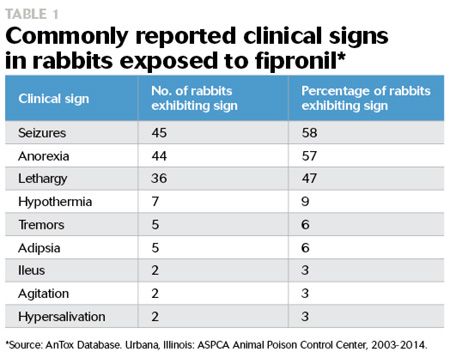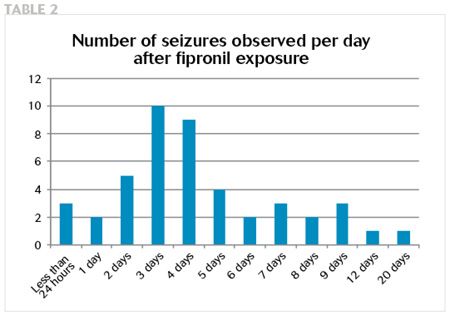Fipronil toxicosis in rabbits
At one time, veterinary spot-on topical fipronil formulations for dogs and cats were recommended for extralabel use in rabbits, but no more. Exposure to these products can cause life-threatening signs in rabbits.

GETTY IMAGESFipronil is a phenylpyrazole insecticide used to control a variety of insects such as ants, beetles, cockroaches, fleas, ticks and termites. It comes in a variety of formulations: topical, spray, dust and bait. This article focuses on the topical spot-on product labeled for use in dogs and cats.
When this product initially debuted, published, extralabel dosing recommendations for fipronil were used successfully in rabbits,1,2 but subsequently, extralabel administration in rabbits has become contraindicated due to toxicity concerns.2,3
Pharmacokinetics and metabolism
Dermal absorption of topically applied fipronil in rabbits is low at 0.07%. Oral absorption is higher at 30% to 50% of the ingested dose and is possible if the rabbit licks the product off after topical application.4 Fipronil is detected on the hair and superficial skin layers but not in the dermis or hypodermis.5 It accumulates in the sebaceous gland and then is released by the follicular ducts.
Mechanism of action
Fipronil blocks GABA receptors in the central nervous system, which leads to the prevention of chloride ion uptake and results in excessive central nervous system stimulation and death. Fipronil exhibits a greater affinity for binding insect GABA receptors than for binding mammalian GABA receptors, resulting in a wide margin of safety for most mammals while still causing death to insects.4
Toxicity
The no observed adverse effect level (NOAEL) for rabbits is 5 mg/kg/day when applied topically.4 Topically applied fipronil is classified as moderately toxic for rabbits.6 The dermal LD50 for rabbits is 354 mg/kg.6
In one study, 10 mg/kg/day of fipronil applied topically to rabbits for 21 days caused decreases in mean body weight, weight gain and food consumption.4 Other studies have shown that dermal dosing in rabbits causes hypersalivation, tremors, hyperactivity, diarrhea, emaciation and death.6 Delays in the appearance of signs were noted in these studies. Seizures were not seen until three to nine days after exposure, and death often occurred 11 to 14 days after exposure.6 Young rabbits have been reported to be more sensitive to the effects of fipronil than older rabbits are.3,7
ASPCA Animal Poison Control Center data
A review of the ASPCA Animal Poison Control Center's toxicology database from 2003 to 2014 yielded 77 fipronil toxicosis cases involving rabbits.8 These cases involved exposure to a single agent (fipronil-containing spot-on products used extralabel, inappropriately or erroneously) and were assessed as medium- or high-suspect cases based on the history of exposure and clinical signs. Of the 77 rabbits, follow-up was not available for 49 (64%), treatment was still continuing in four (5%), a full recovery was noted in three (4%), and death or euthanasia was observed in 21 (27%).8
The most commonly reported clinical signs observed in this review were seizures, anorexia, lethargy, hypothermia, tremors, adipsia, ileus, agitation and hypersalivation (Table 1). The gastrointestinal signs and depression often, but not always, preceded the tremors and seizures.8

The onset of seizures was often markedly delayed from the exposure, starting as soon as a couple hours after exposure to as long as 20 days later (Table 2). In one case, mild seizures lasted several weeks.8

Monitoring
Monitor the patient's food and water intake, as anorexia and adipsia are common. Also monitor the patient for changes in body temperature, tremors and seizure activity.
Treatment
Bathing the rabbit with liquid dishwashing detergent within 48 hours of the exposure will easily remove the fipronil.9 After 48 hours, bathing is probably minimally effective. Special care should be taken to keep the rabbit warm during and after bathing until its fur is fully dry.
Benzodiazepines, such as diazepam (1 to 3 mg/kg intramuscularly or intravenously) or midazolam (1 to 2 mg/kg intramuscularly or intravenously), can be given to treat seizure-like activity.10 For patients with seizures lasting longer than 48 hours, levetiracetam therapy can be initiated (20 mg/kg orally t.i.d., potentially for a few weeks).11
Maintenance fluids (100 to 120 ml/kg/day) should be administered to maintain the patient's hydration.11 Nutritional support, such as Critical Care (Oxbow Animal Health; 10 to 15 ml/kg orally b.i.d. to t.i.d.), may be indicated in anorectic rabbits.11 Often, inappetant rabbits may consume this voluntarily, but force feeding with a syringe may be indicated when continued feed refusal is present. If the rabbit is hypothermic, provide an external heat source, such as a heating pad or warming blanket.
Conclusion
Fipronil has a narrow margin of safety in rabbits. Its administration is contraindicated because of the potential for life-threatening signs and the availability of safer alternative spot-on products for external parasite control.
Seizures, anorexia, adipsia and lethargy are common clinical signs in rabbits exposed to topical fipronil products. The onset of seizures may be greatly delayed in these patients, and at-home monitoring for the development of seizures for several weeks after exposure is warranted. Mild seizures may last for several weeks. The prognosis is guarded for all rabbits exhibiting seizures.9
Laura A. Stern, DVM
ASPCA Animal Poison Control Center
1717 S. Philo Road, Suite 36
Urbana, IL 61802
References
1. Cutler SL. Ectopic Psoroptes cunuculi infestataion in a pet rabbit. J Small Anim Pract 1999;39:86-87.
2. Webster M. Product warning: FRONTLINE [letter]. Aust Vet J 1999;77:202.
3. Gupta RC. Fipronil. In: Veterinary toxicology: basic and clinical principles. 2nd ed. Amsterdam: Elsevier, 2012;604-608.
4. Jackson D, Cornell CB, Luukinen B, et al. Fipronil technical fact sheet. National Pesticide Information Center, Oregon State University Extension Services 2009. Available at: http://npic.orst.edu/factsheets/fiptech.pdf.
5. Cochet P, Birckel P, Bromet-Petit M, et al. Skin distribution of fipronil by microautoradiology following topical administration to the beagle dog. Eur J Drug Metab Pharmacokinet 1997;22:211-216.
6. FAO, WHO. Fipronil: pesticide residues in food-1997, in Proceedings. Joint Meet FAO Panel Experts Pesticide Residue Food Environment WHO Core Assessment Group, 1997;5.
7. Johnston MS. Clinical toxicoses of domestic rabbits. Vet Clin North Am Exot Anim Pract 2008;11:315-326.
8. AnTox Database. Urbana, Illinois: ASPCA Animal Poison Control Center, 2003-2014.
9. Wismer T. Novel insecticides: fipronil. In: Plumlee KH, ed. Clinical veterinary toxicology. St. Louis: Mosby, 2004;183-184.
10. Quesenberry KE, Carpenter JW. Formulary. In: Ferrets, rabbits and rodents: clinical medicine and surgery. 2nd ed. St. Louis: Saunders, 2004;436-444.
11. Carpenter JW. Exotic animal formulary. 4th ed. St. Louis, Mo: Elsevier, 2013;529-539.

The ASPCA Animal Poison Control Center (APCC) is a 24-hour animal emergency consultation service that provides treatment and diagnostic recommendations to animal owners and veterinarians regarding animal poisoning cases 24 hours a day, 7 days a week, 365 days a year. Since 1978, the veterinary staff at the APCC has experience of handling more than 2 million animal poisoning cases involving pesticides, herbicides, plants, human and animal drugs, heavy metals, and many other potentially hazardous chemicals. A $65 consultation fee may apply. This includes follow-up consultations for the duration of the case. If you think your animal may have ingested a potentially poisonous substance, call (888) 426-4435. Additional information can be found online at www.aspca.org/apcc.